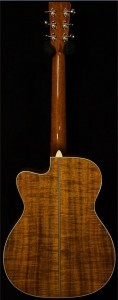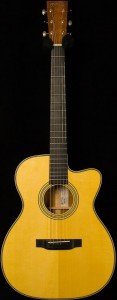Juber’s Juber is a top shelf OMC-44K and then some
Koa and Adirondack Served Up Light and Lively
Laurence Juber recorded his album “Under an Indigo Sky” entirely with the most recent version of his C.F. Martin signature model, the OMC-44K LJ. It has been a rare occurrence when this singular master musician likes a single guitar so much he uses it exclusively when making one of his many dozens of records. But then, it is no ordinary guitar.
This OMC-44K LJ has an Orchestra Model body size, with a Cutaway and it is made in a modern version of Martin’s Style 44, with back and sides of Hawaiian Koa wood, known for its unique combination of clear trebles, warm harmonics, but with a more open mid-range compared to other rich tonewoods like rosewood. Just the way Laurence Juber likes it.
A Juber model that stands apart

This isn’t the only studio album Juber recorded with an individual guitar. The first was made up of tunes composed by Harold Arlen and featured the Madagascar rosewood version of his signature model. What sets this new Juber model apart is the use of traditional hot hide glue for the construction, and also the neck, which is made from lightweight Spanish cedar. Commonly found on classical guitars, Spanish cedar was used for most Martins made in the nineteenth century. Having no relation to the cedars of North America, it is actually from the mahogany family of Central and South America, but it is softer and less dense than Big Leaf mahogany.
When he first told me about the guitar, in the summer of 2011, LJ described it as a sort of “experiment”. He had wanted to do a koa edition for some time, but the primary goal was to create the lightest and most responsive Juber model yet, with warmth but also clarity and less presence in the undertone of the low mids. As he put it back then, it would be something along the lines of “a steel string classical guitar.”
Coincidentally, Style 44 was invented specifically for classical virtuoso Vahdah Olcott, and it debuted in 1913, 100 years ago. Fewer than thirty-five Style 44 Martins are known to exist, most made for Miss Olcott (later Mrs. Olcott-Bickford), or her students. They were sold through the Ditson department store, with the last two Style 44 Martins being made in 1932. That is, until now.
The Very Best Woods
Juber wanted his latest signature model to have the best Adirondack spruce soundboard Martin could supply. But Martin replied this would require a 40 Series designation and pricing. The 40s usually come with all sorts of flashy abalone inlay. Like Olcott-Bickford, LJ wanted a blank fingerboard and wooden purfling while also getting the highest grade tonewoods.
Although Martins have been made with Hawaiian koa since the 1830s, it was not until the Hawaiian music crazy of the nineteen-teens that they became common place – the exact time period of the Olcott-Bickford 44s.
Dick Boak of Martin came up with the idea to revive the Style 44 designation for this limited run of LJ guitars, which come with the kind of extra-flamey koa and the highest quality Adirondack spruce worthy of a top-of-the-line OM-45. But otherwise the OMC-44K LJ has the herringbone trim, wood fiber rosette and blank ebony fingerboard and belly bridge of the previous Juber models.
Light Construction, Lively Dynamics
“The hide glue makes a big difference. The koa body and Spanish cedar neck combo keep it ‘light and lively’. The low mid-range is well-controlled, so there was very little EQ or compression.” He would know, having recorded with two LJ Signature model editions made in mahogany, as well as three made from three different species of rosewood, and one made with American maple.
This one is clearly unique among Juber models and among Martin OMs. The koa provides fundamental notes with steady sustain that outlive the warm glow around the bass notes, and there is an open and airy undertone below the mid-range. And up top, the trebles are clear and gossamer thin, with that wonderful violin-like purity only found in the best Martin OMs.
Because of the lighter construction, it is extremely responsive, and the album was recorded and mixed so expertly that the slightest nuance is heard with brilliant clarity. There is always a bit of a tradeoff between power and responsiveness. Although it has the same 1/4″ scalloped bracing of the Vintage Series OMs, the lighter build means the guitar doesn’t have as fat and powerful a sound when played hard, compared to something like an OM-42, or for that matter a typical Juber model. But the pay off is in sensitivity and effortless resonance.
And it is not like the guitar is under-built. Juber uses medium gauge treble strings (as part a GHS True Medium set, .56, .42, .32, .24, .17, .13) and can dig in to take a guitar to the limits of its tolerance. But it is also noticeable how he enjoys playing this guitar softly, coaxing and caressing the finely tuned instrument to radiate under its own power.
Having seen Juber playing his 44K on stage, and now hearing this record, I would venture to say only the recent CS-OM-13 limited edition Martin comes close it in terms of dynamics, resonance and responsiveness.
The results of this 44K Juber experiment were a resounding success, and the koa version was made available for sale to the public as a limited edition of 25 instruments.
The Ditson department store went out of business in the Great Depression. But this Style 44 Martin was also available exclusively through one dealer, Wildwood Guitars of Louisville, Colorado. There is only one right-handed example left for sale (plus one left-handed version.) And here it is.
And here is LJ going into more detail about the guitar for the editors of Guitar Player Magazine.
And that is one man’s word on…

One thought on “Martin OMC-44K LJ”